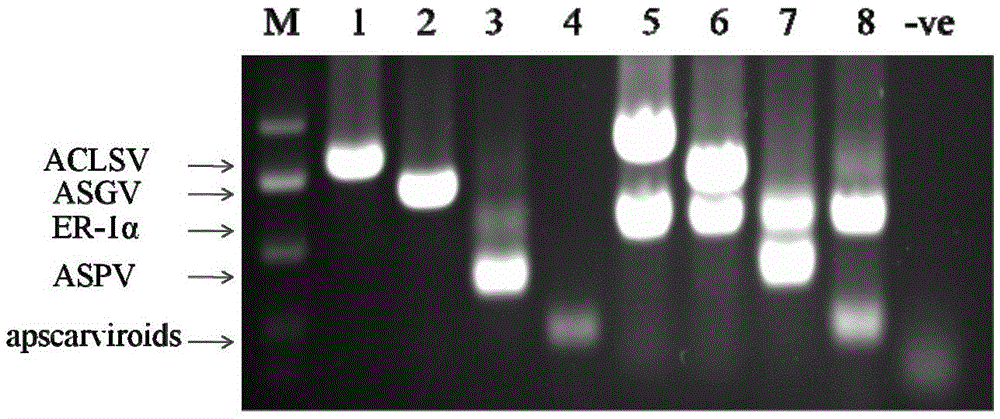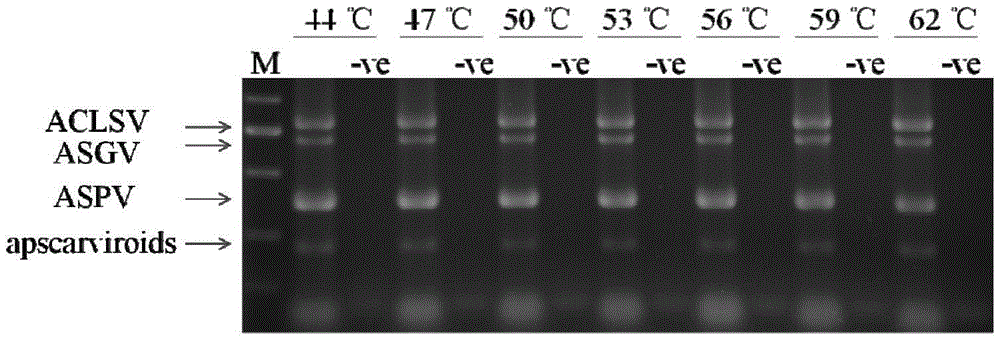Multiplex RT-PCR Detection Method for Latent Viruses and Viroids in Apple
An apple latent virus, RT-PCR technology, applied in microorganism-based methods, biochemical equipment and methods, and microbial determination/inspection, etc., can solve the problems of high efficiency of multiplex PCR, no simultaneous detection, etc., to improve the results. The effect of discriminating accuracy, reducing non-specific amplification, and improving detection accuracy and sensitivity
- Summary
- Abstract
- Description
- Claims
- Application Information
AI Technical Summary
Problems solved by technology
Method used
Image
Examples
Embodiment 1
[0052] The acquisition of multiple RT-PCR detection primer combination of embodiment 1 apple latent virus and viroid
[0053] Referring to the existing literature and the sequences reported in GenBank, screen and design multiple RT-PCR primers, aiming to make the selected primers applicable to all latent viruses and viroids of apples that have been identified in my country, and can specifically obtain the target fragments, and each target fragment can be clearly distinguished by agarose gel electrophoresis. Finally, four pairs of primers for ACLSV (794bp), ASGV (666bp), ASPV (346bp) and apscarviroids (220bp) in Table 1 were designed and selected. In order to reduce the generation of false positives, the apple genome EF-1α (520bp) was used as the internal standard gene. It was verified by conventional PCR. It can be seen that the selected primers can clearly and specifically obtain the target fragment, the primer dimer is not obvious, and there is no obvious interference betwee...
Embodiment 2
[0056] The establishment and optimization of the multiple RT-PCR system of embodiment 2 apple latent virus and viroid
[0057] 1. Determine the sampling location and sampling method
[0058] In order to make the established multiple RT-PCR technique more widely applicable, according to the distribution characteristics of latent viruses and viroids in apple plants, it was determined that leaves, branches, flowers and fruits could be used as sampling sites. Among them, the leaves and flowers can be used to directly grind and extract the total plant RNA, the branches need to use a blade to peel off the phloem for grinding, and the fruit needs to peel off the pericarp.
[0059] 2. Extract total RNA: extract total RNA by CTAB-phenol method
[0060] Prepare RNA extraction buffer:
[0061]
[0062] Take 0.1g sample, grind it with liquid nitrogen, quickly transfer it to a 1.5ml centrifuge tube, add 500 μL water-saturated phenol, chloroform and isoamyl alcohol mixture (phenol: chl...
Embodiment 3
[0086] Example 3 Detection of orchard apple samples and specificity verification
[0087] Using apple samples collected from an orchard as materials, total RNA was extracted as a template to verify the feasibility of the established multiplex RT-PCR technology.
[0088] Extraction of total RNA, reverse transcription, multiplex PCR reaction system and optimized PCR reaction conditions are the same as those described in Example 2. The results show that the detection results have achieved very good results ( Figure 5 ).
[0089] In order to verify the specificity of virus detection, the bands after electrophoresis were respectively subjected to gel cutting, recovery and purification, cloning and sequence determination. Blastn alignment was performed on the obtained sequences in GenBank, and the results showed that the virus sequence corresponding to each band was consistent with the target virus sequence, indicating that the method was highly specific.
PUM
 Login to View More
Login to View More Abstract
Description
Claims
Application Information
 Login to View More
Login to View More - R&D
- Intellectual Property
- Life Sciences
- Materials
- Tech Scout
- Unparalleled Data Quality
- Higher Quality Content
- 60% Fewer Hallucinations
Browse by: Latest US Patents, China's latest patents, Technical Efficacy Thesaurus, Application Domain, Technology Topic, Popular Technical Reports.
© 2025 PatSnap. All rights reserved.Legal|Privacy policy|Modern Slavery Act Transparency Statement|Sitemap|About US| Contact US: help@patsnap.com



